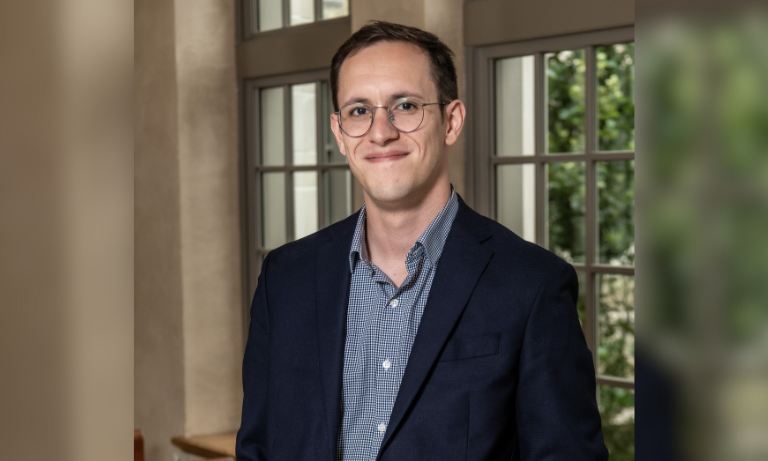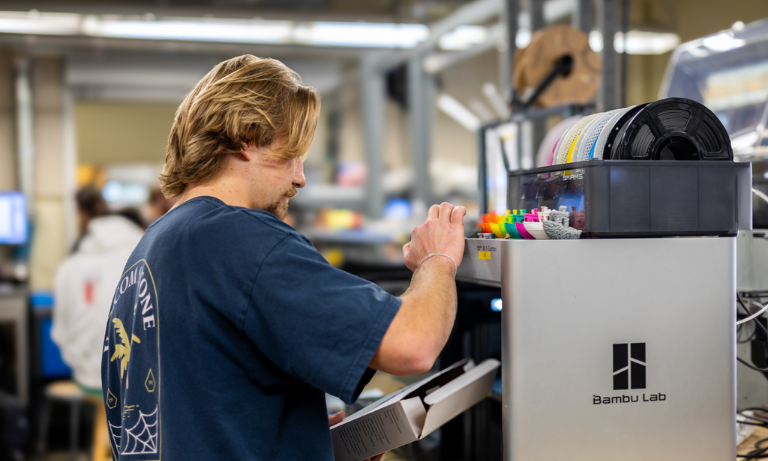Each week, the College of Engineering features an outstanding member of the engineering community to be part of its spotlight campaign. This week, we are highlighting Luke Perreault, biomedical engineering Assistant Professor.
What brought you to Cal Poly College of Engineering?
I was teaching in a brand-new engineering program for the past couple of years, and I loved the opportunities it gave me. The dynamic community allowed me to be creative in my teaching and engage students in research. However, after visiting Cal Poly, I felt like I found the same kind of program on a larger scale. The program has students who are friendly, optimistic and curious, and faculty who are creative, driven and committed to their community. I felt like I could learn to be a better version of myself here and contribute something positive and new. When I got back from my interview at Cal Poly, my wife said it was the first time I’d come home unequivocally excited about a new university. We packed our family up and flew across the country to be here, and it’s exactly what I’d hoped for.
Tell me about your research interests and why you are passionate about this topic.
My training is in biomaterials and tissue engineering, and I predominantly study and use extracellular matrices in my work to create and inspire different engineered tissues. In short, I develop environments in which we can recreate living tissues: What kind of materials can we use to make scaffolds that cells will respond to and grow inside? How can we design better bioreactors to effectively nurture tissue growth? And so on.
What do you want others to know about your research? Why is your topic important?
Bioengineering is growing rapidly. Biofabrication techniques like 3D bioprinting, advances in bioreactor technology and production of complex engineered tissues are all creating new opportunities. The challenge now is finding out how to do these things affordably, sustainably and equitably so we can all benefit from these innovations. That’s the ethos I want to impart to students with my research.
What are some of the upcoming projects or publications you’re working on?
I’m working on a collaborative project from my postdoc to model oxygen transport in bioreactor systems, which is important for scaling up cell and tissue production. I’m also working on repurposing decellularized plant scaffolds (for example, a leaf, with all the cells stripped out) that I’ve used in my research for a tissue engineering lab module here at Cal Poly in which students can design and test their own plant-derived biomaterials.
What is your favorite part of your job?
The conversations you get to have with students while you’re working in the lab or doing class projects. I get to hear about what they want to do with their careers and learn about their lives and communities. It’s the best.
What is your favorite place in San Luis Obispo County and why?
I’ve only been here a couple of months, but it’s awfully hard not to fall in love with Avila Beach.
How do you like to spend your free time?
I have two daughters, a 4-year-old and a 3-month-old. Since we’ve been in SLO, my wife and I have really enjoyed taking them hiking and exploring the area.
What is the most helpful advice you’ve received?
My dad used to say that even if everything else you try to do crashes and burns, if you made someone else’s day a little bit better, then that was a good day.
How do you encourage engineering students to make an impact on the community?
Communicate and listen. There are a million problems in the world and twice as many solutions, but finding them starts with truly understanding and empathizing with other people and the challenges they face.
How do you support the college’s commitment to justice, equity, diversity and inclusion?
I love developing opportunities to engage K-12 students in bioscience and engineering and to get undergraduates involved in outreach. Everyone brings a unique perspective to engineering, and it’s important for our fields to reflect the diversity of the communities they serve. Sharing our enthusiasm for our work and making communities where engineering can belong to everyone is how we get there.
By Taylor Villanueva


